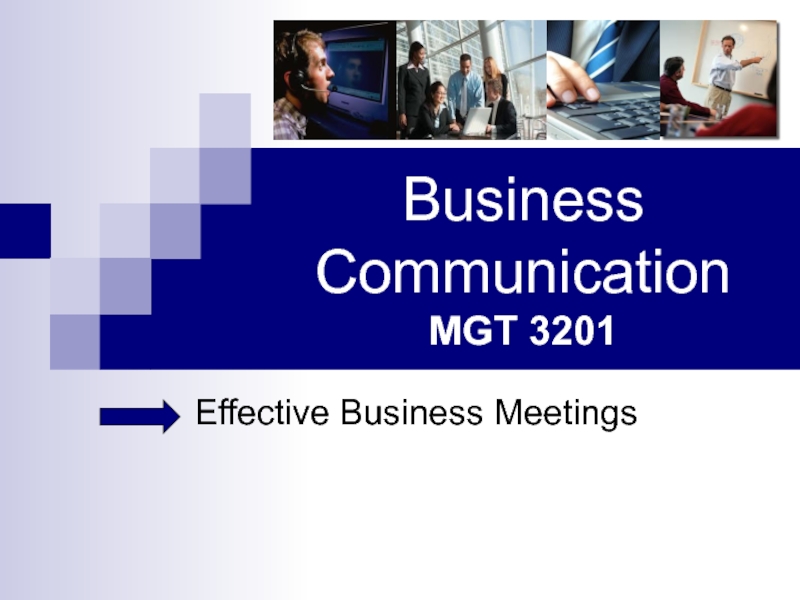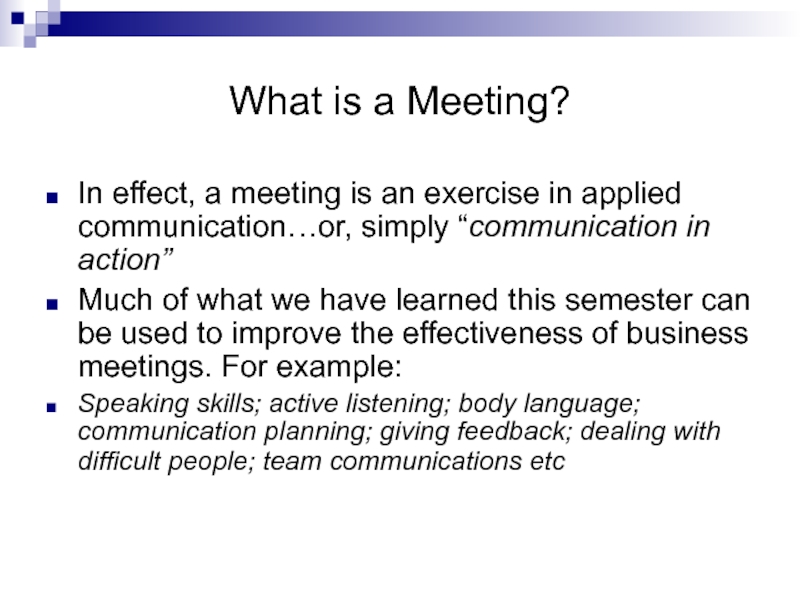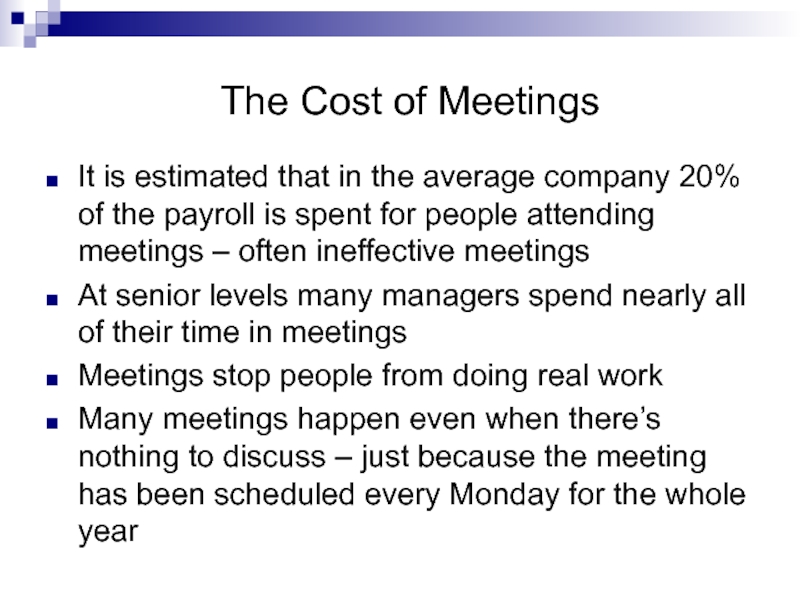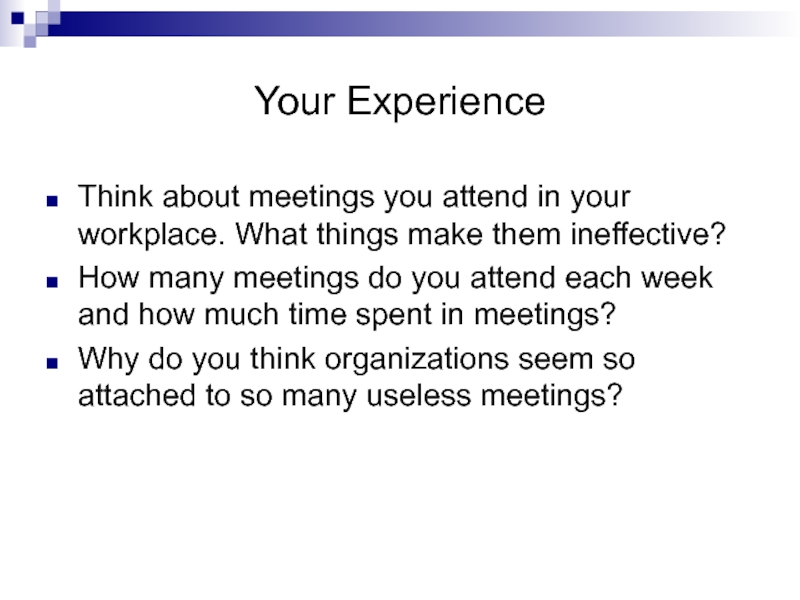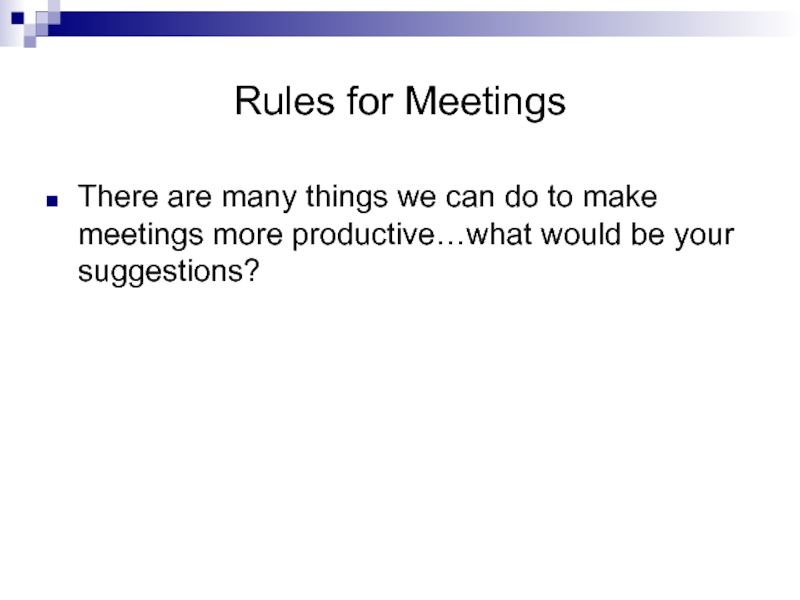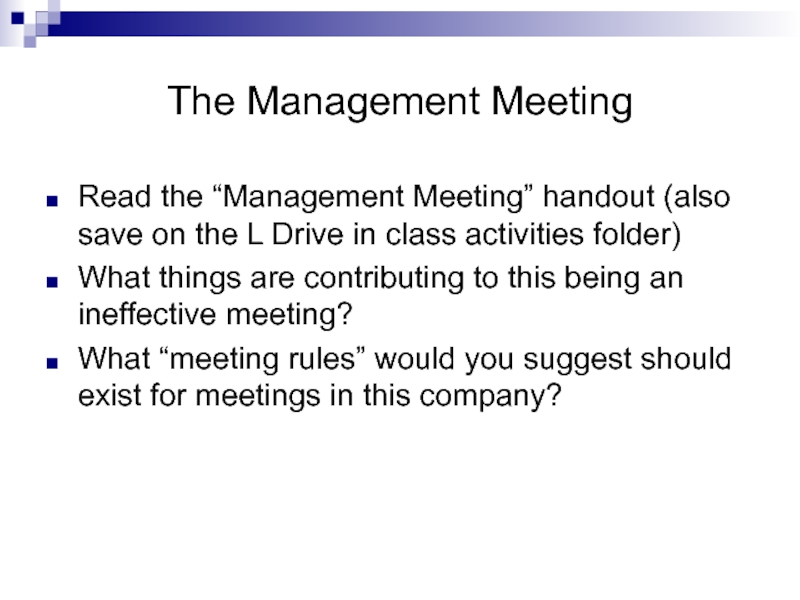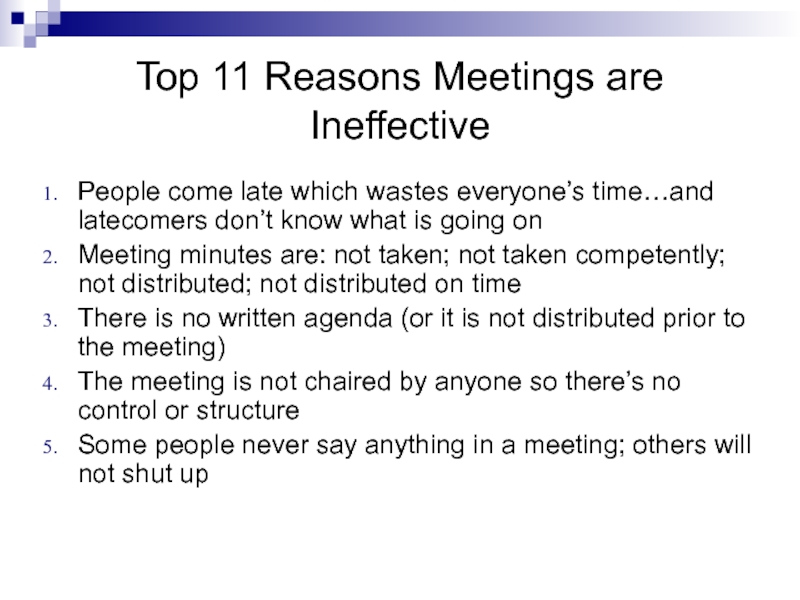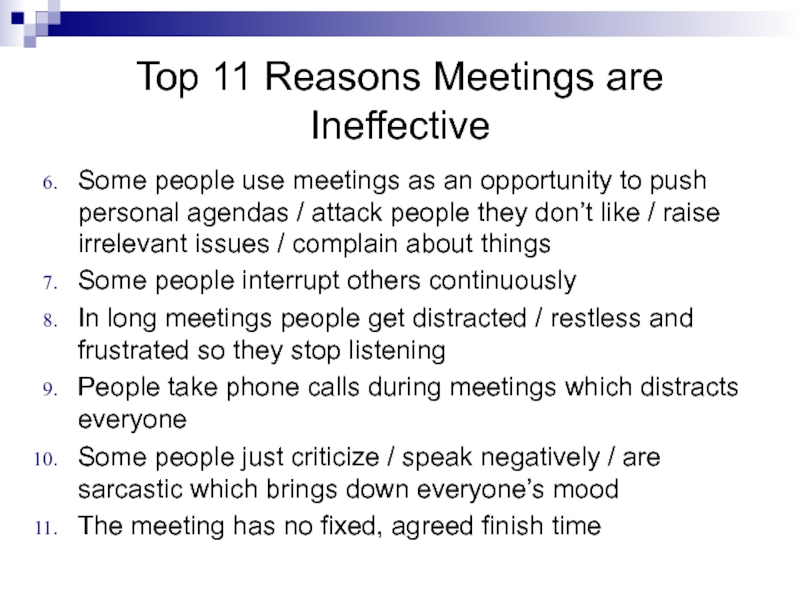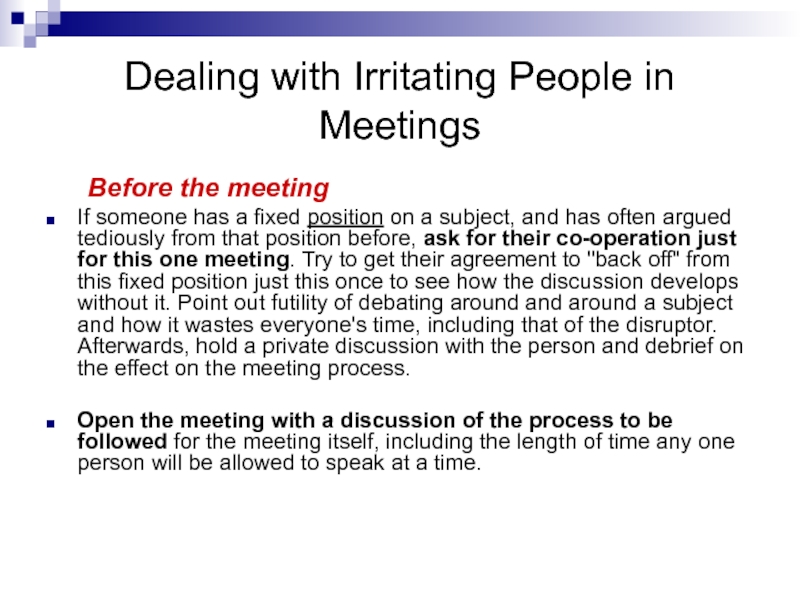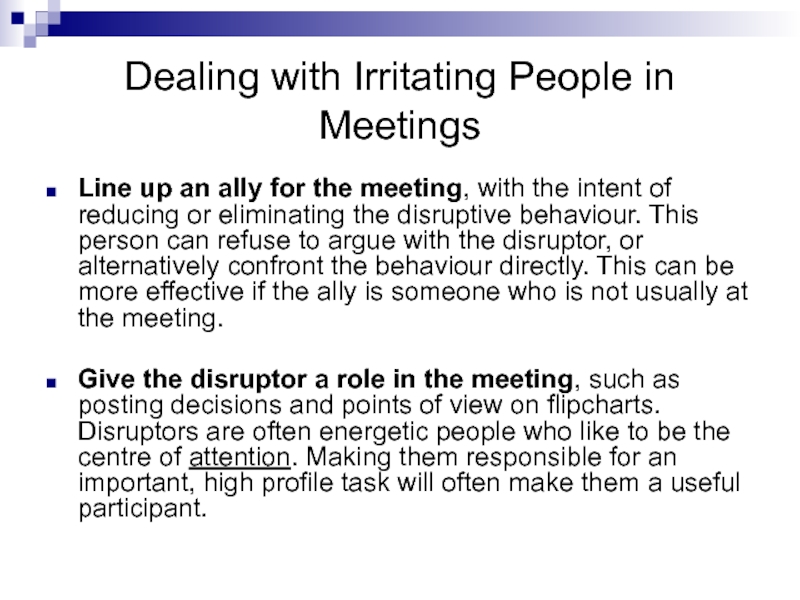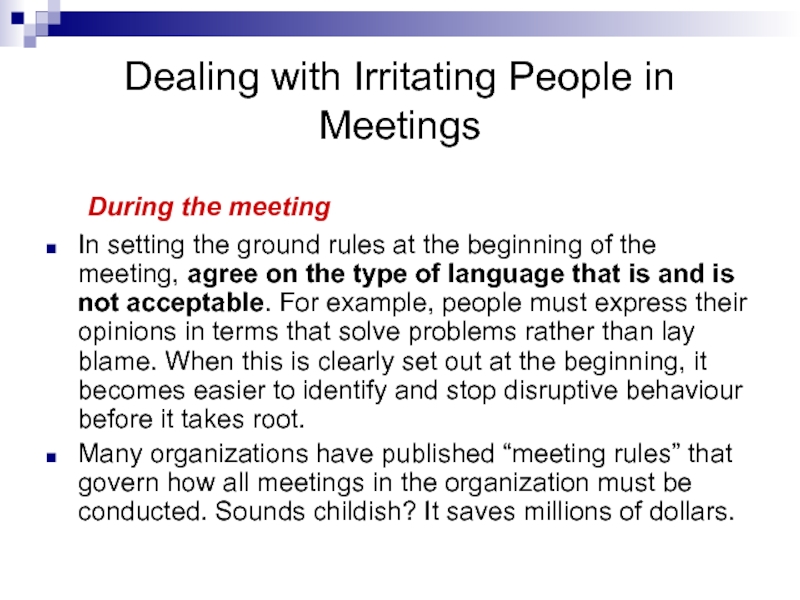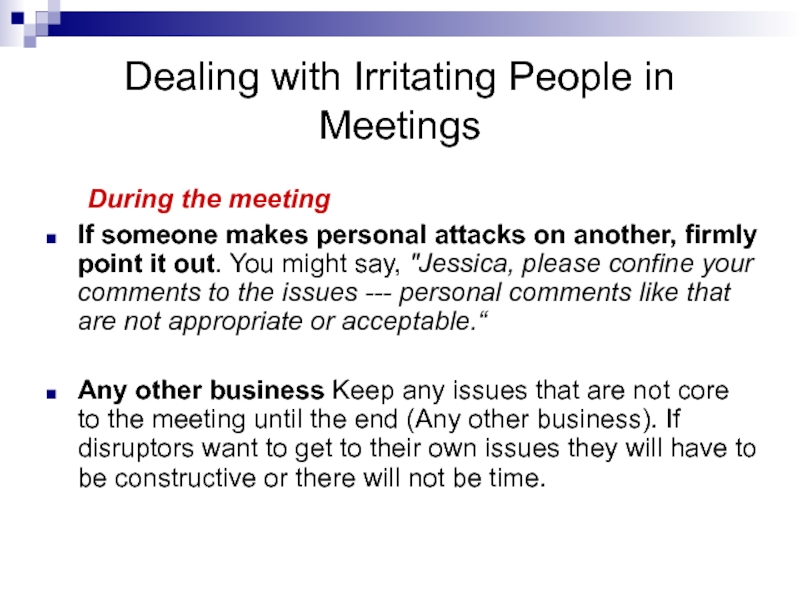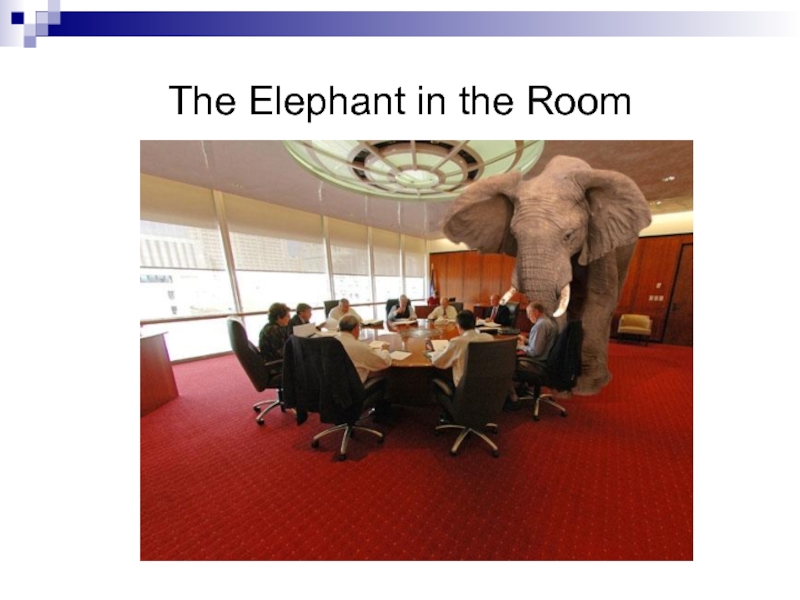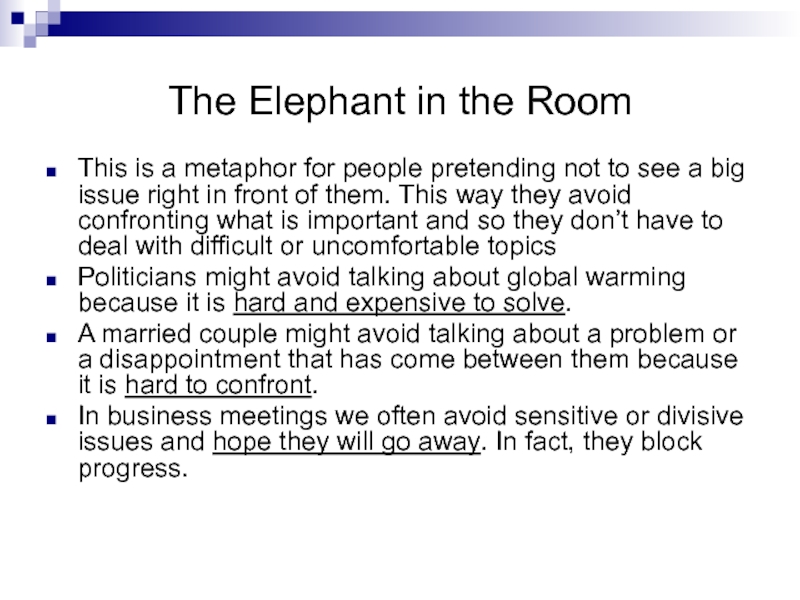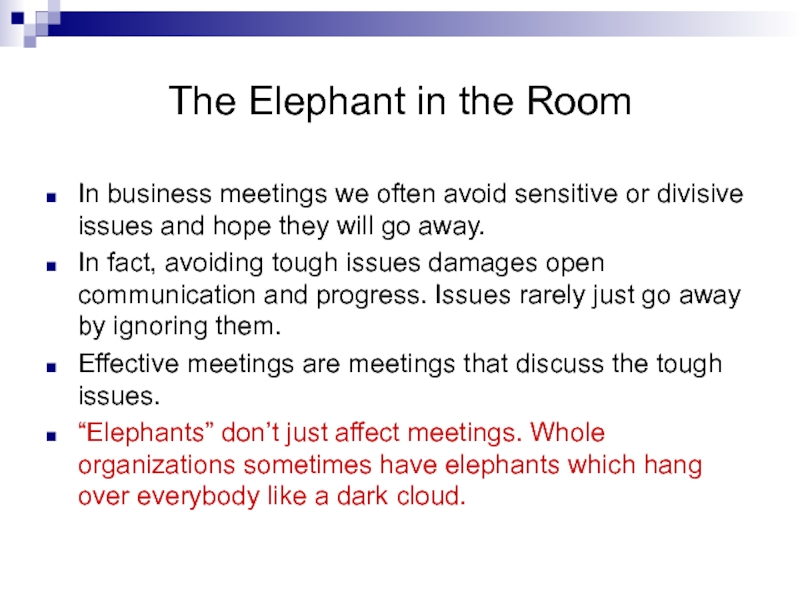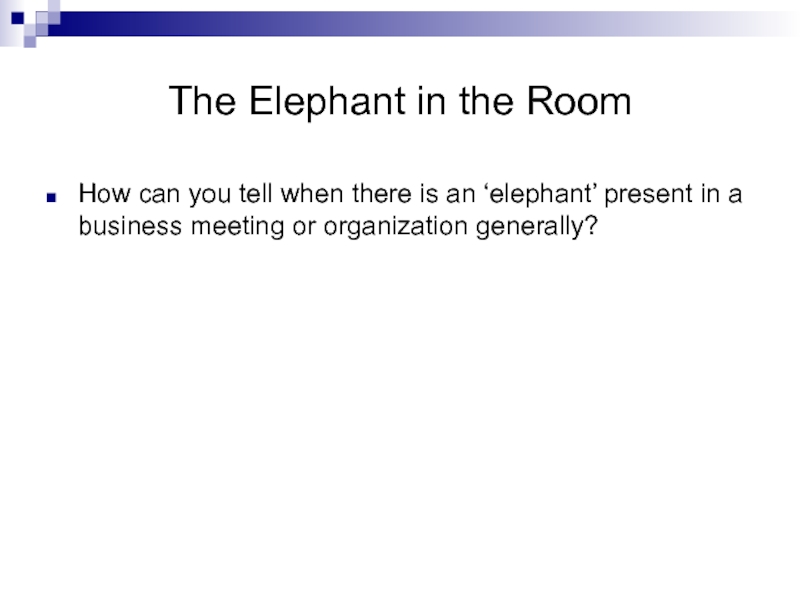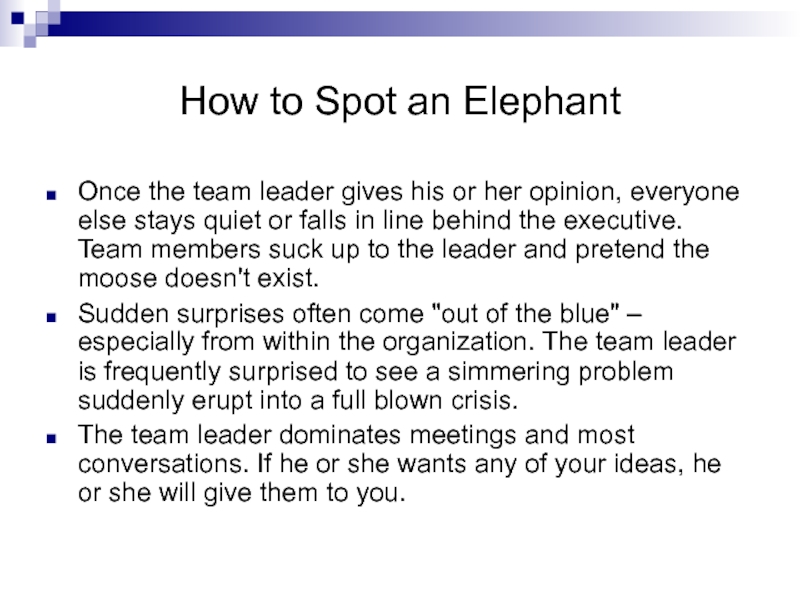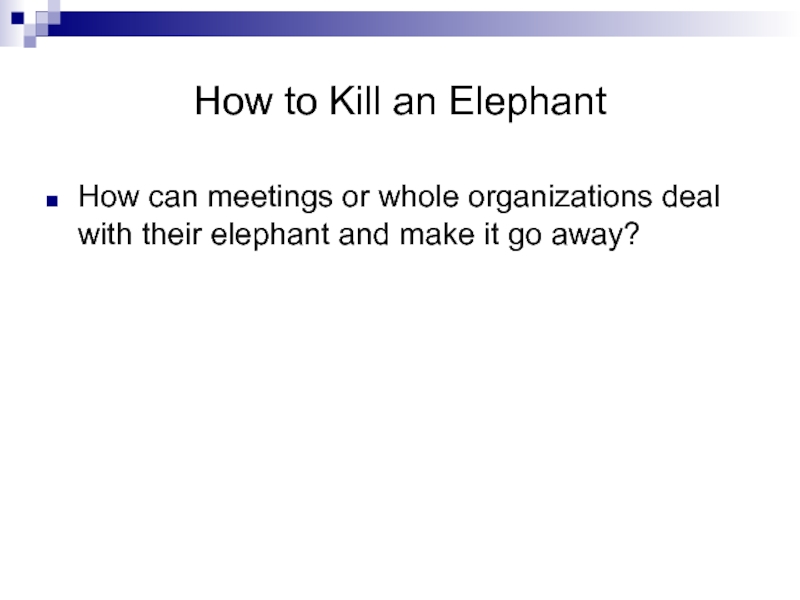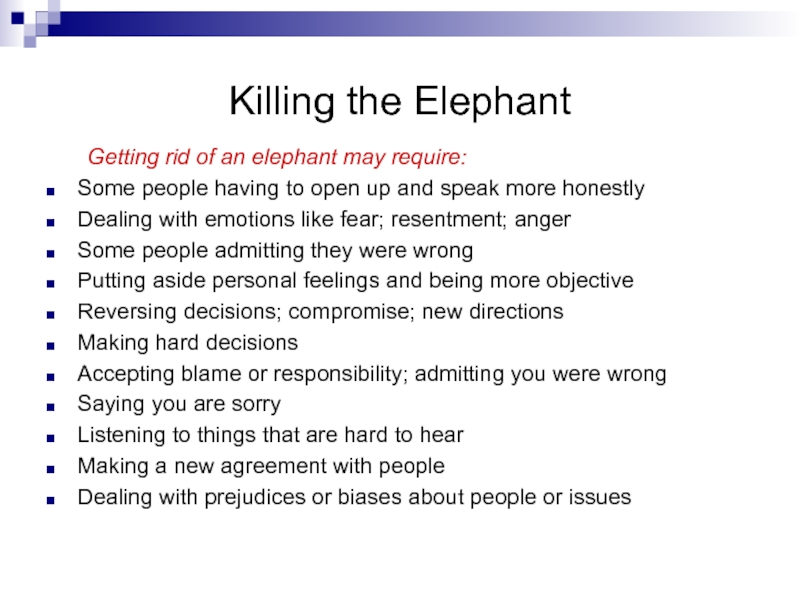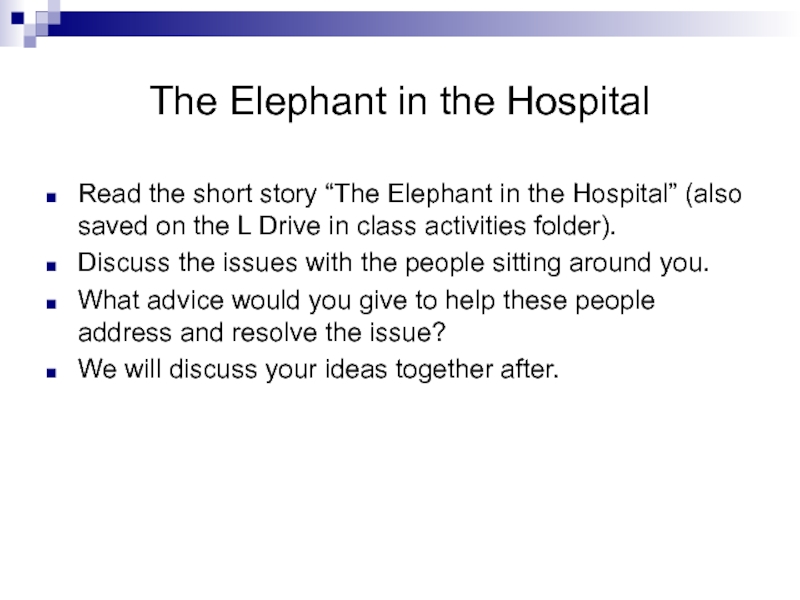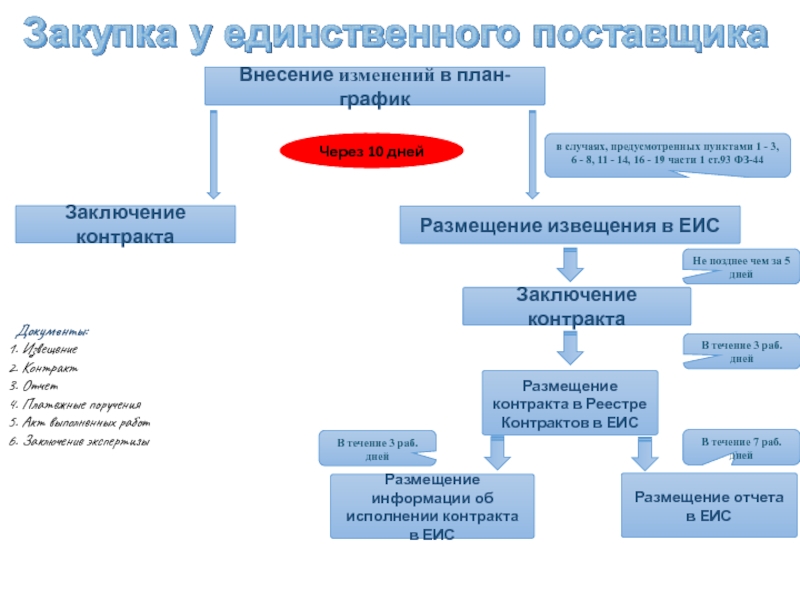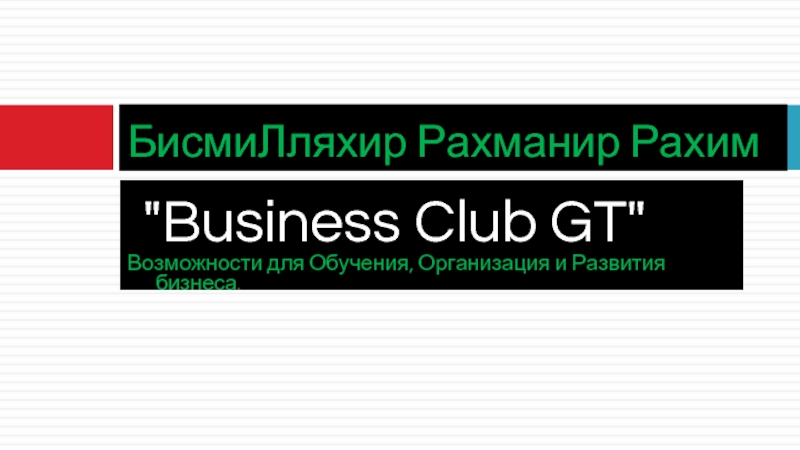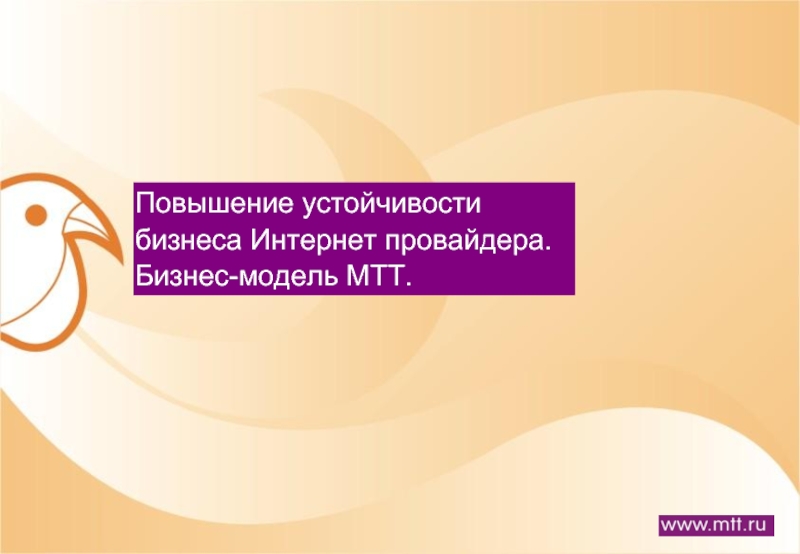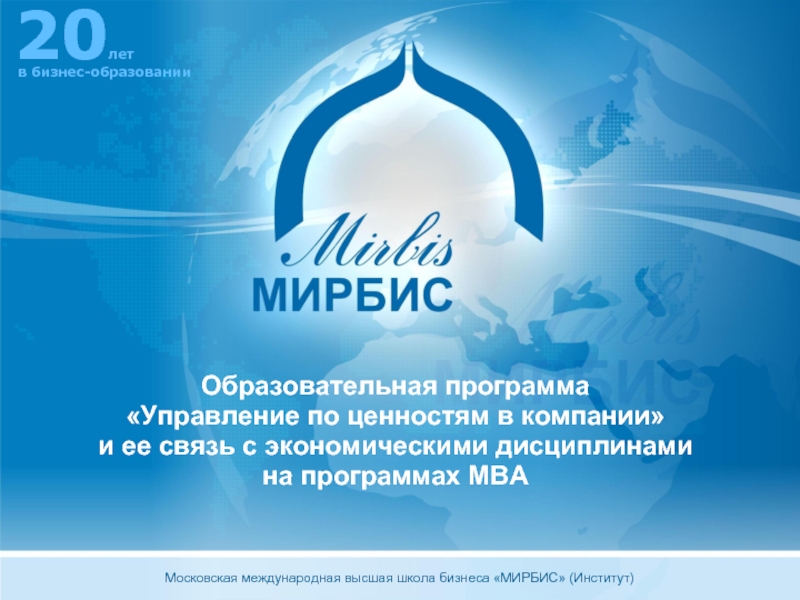- Главная
- Разное
- Дизайн
- Бизнес и предпринимательство
- Аналитика
- Образование
- Развлечения
- Красота и здоровье
- Финансы
- Государство
- Путешествия
- Спорт
- Недвижимость
- Армия
- Графика
- Культурология
- Еда и кулинария
- Лингвистика
- Английский язык
- Астрономия
- Алгебра
- Биология
- География
- Детские презентации
- Информатика
- История
- Литература
- Маркетинг
- Математика
- Медицина
- Менеджмент
- Музыка
- МХК
- Немецкий язык
- ОБЖ
- Обществознание
- Окружающий мир
- Педагогика
- Русский язык
- Технология
- Физика
- Философия
- Химия
- Шаблоны, картинки для презентаций
- Экология
- Экономика
- Юриспруденция
Business Communications (lecture 23) Effective Business Meetings презентация
Содержание
- 1. Business Communications (lecture 23) Effective Business Meetings
- 2. What is a Meeting? In effect, a
- 3. The Cost of Meetings It is estimated
- 4. Your Experience Think about meetings you attend
- 5. Rules for Meetings There are many things
- 6. The Management Meeting Read the “Management Meeting”
- 7. Top 11 Reasons Meetings are Ineffective People
- 8. Top 11 Reasons Meetings are Ineffective Some
- 9. Dealing with Irritating People in Meetings Before
- 10. Dealing with Irritating People in Meetings Line
- 11. Dealing with Irritating People in Meetings During
- 12. Dealing with Irritating People in Meetings During
- 13. The Elephant in the Room
- 14. The Elephant in the Room This is
- 15. The Elephant in the Room In business
- 16. The Elephant in the Room How can
- 17. How to Spot an Elephant The real
- 18. How to Spot an Elephant Once the
- 19. How to Kill an Elephant How can
- 20. Killing the Elephant Getting rid of an
- 21. The Elephant in the Hospital Read the
Слайд 2What is a Meeting?
In effect, a meeting is an exercise in
applied communication…or, simply “communication in action”
Much of what we have learned this semester can be used to improve the effectiveness of business meetings. For example:
Speaking skills; active listening; body language; communication planning; giving feedback; dealing with difficult people; team communications etc
Much of what we have learned this semester can be used to improve the effectiveness of business meetings. For example:
Speaking skills; active listening; body language; communication planning; giving feedback; dealing with difficult people; team communications etc
Слайд 3The Cost of Meetings
It is estimated that in the average company
20% of the payroll is spent for people attending meetings – often ineffective meetings
At senior levels many managers spend nearly all of their time in meetings
Meetings stop people from doing real work
Many meetings happen even when there’s nothing to discuss – just because the meeting has been scheduled every Monday for the whole year
At senior levels many managers spend nearly all of their time in meetings
Meetings stop people from doing real work
Many meetings happen even when there’s nothing to discuss – just because the meeting has been scheduled every Monday for the whole year
Слайд 4Your Experience
Think about meetings you attend in your workplace. What things
make them ineffective?
How many meetings do you attend each week and how much time spent in meetings?
Why do you think organizations seem so attached to so many useless meetings?
How many meetings do you attend each week and how much time spent in meetings?
Why do you think organizations seem so attached to so many useless meetings?
Слайд 5Rules for Meetings
There are many things we can do to make
meetings more productive…what would be your suggestions?
Слайд 6The Management Meeting
Read the “Management Meeting” handout (also save on the
L Drive in class activities folder)
What things are contributing to this being an ineffective meeting?
What “meeting rules” would you suggest should exist for meetings in this company?
What things are contributing to this being an ineffective meeting?
What “meeting rules” would you suggest should exist for meetings in this company?
Слайд 7Top 11 Reasons Meetings are Ineffective
People come late which wastes everyone’s
time…and latecomers don’t know what is going on
Meeting minutes are: not taken; not taken competently; not distributed; not distributed on time
There is no written agenda (or it is not distributed prior to the meeting)
The meeting is not chaired by anyone so there’s no control or structure
Some people never say anything in a meeting; others will not shut up
Meeting minutes are: not taken; not taken competently; not distributed; not distributed on time
There is no written agenda (or it is not distributed prior to the meeting)
The meeting is not chaired by anyone so there’s no control or structure
Some people never say anything in a meeting; others will not shut up
Слайд 8Top 11 Reasons Meetings are Ineffective
Some people use meetings as an
opportunity to push personal agendas / attack people they don’t like / raise irrelevant issues / complain about things
Some people interrupt others continuously
In long meetings people get distracted / restless and frustrated so they stop listening
People take phone calls during meetings which distracts everyone
Some people just criticize / speak negatively / are sarcastic which brings down everyone’s mood
The meeting has no fixed, agreed finish time
Some people interrupt others continuously
In long meetings people get distracted / restless and frustrated so they stop listening
People take phone calls during meetings which distracts everyone
Some people just criticize / speak negatively / are sarcastic which brings down everyone’s mood
The meeting has no fixed, agreed finish time
Слайд 9Dealing with Irritating People in Meetings
Before the meeting
If someone has a
fixed position on a subject, and has often argued tediously from that position before, ask for their co-operation just for this one meeting. Try to get their agreement to "back off" from this fixed position just this once to see how the discussion develops without it. Point out futility of debating around and around a subject and how it wastes everyone's time, including that of the disruptor. Afterwards, hold a private discussion with the person and debrief on the effect on the meeting process.
Open the meeting with a discussion of the process to be followed for the meeting itself, including the length of time any one person will be allowed to speak at a time.
Open the meeting with a discussion of the process to be followed for the meeting itself, including the length of time any one person will be allowed to speak at a time.
Слайд 10Dealing with Irritating People in Meetings
Line up an ally for the
meeting, with the intent of reducing or eliminating the disruptive behaviour. This person can refuse to argue with the disruptor, or alternatively confront the behaviour directly. This can be more effective if the ally is someone who is not usually at the meeting.
Give the disruptor a role in the meeting, such as posting decisions and points of view on flipcharts. Disruptors are often energetic people who like to be the centre of attention. Making them responsible for an important, high profile task will often make them a useful participant.
Give the disruptor a role in the meeting, such as posting decisions and points of view on flipcharts. Disruptors are often energetic people who like to be the centre of attention. Making them responsible for an important, high profile task will often make them a useful participant.
Слайд 11Dealing with Irritating People in Meetings
During the meeting
In setting the ground
rules at the beginning of the meeting, agree on the type of language that is and is not acceptable. For example, people must express their opinions in terms that solve problems rather than lay blame. When this is clearly set out at the beginning, it becomes easier to identify and stop disruptive behaviour before it takes root.
Many organizations have published “meeting rules” that govern how all meetings in the organization must be conducted. Sounds childish? It saves millions of dollars.
Many organizations have published “meeting rules” that govern how all meetings in the organization must be conducted. Sounds childish? It saves millions of dollars.
Слайд 12Dealing with Irritating People in Meetings
During the meeting
If someone makes personal
attacks on another, firmly point it out. You might say, "Jessica, please confine your comments to the issues --- personal comments like that are not appropriate or acceptable.“
Any other business Keep any issues that are not core to the meeting until the end (Any other business). If disruptors want to get to their own issues they will have to be constructive or there will not be time.
Any other business Keep any issues that are not core to the meeting until the end (Any other business). If disruptors want to get to their own issues they will have to be constructive or there will not be time.
Слайд 14The Elephant in the Room
This is a metaphor for people pretending
not to see a big issue right in front of them. This way they avoid confronting what is important and so they don’t have to deal with difficult or uncomfortable topics
Politicians might avoid talking about global warming because it is hard and expensive to solve.
A married couple might avoid talking about a problem or a disappointment that has come between them because it is hard to confront.
In business meetings we often avoid sensitive or divisive issues and hope they will go away. In fact, they block progress.
Politicians might avoid talking about global warming because it is hard and expensive to solve.
A married couple might avoid talking about a problem or a disappointment that has come between them because it is hard to confront.
In business meetings we often avoid sensitive or divisive issues and hope they will go away. In fact, they block progress.
Слайд 15The Elephant in the Room
In business meetings we often avoid sensitive
or divisive issues and hope they will go away.
In fact, avoiding tough issues damages open communication and progress. Issues rarely just go away by ignoring them.
Effective meetings are meetings that discuss the tough issues.
“Elephants” don’t just affect meetings. Whole organizations sometimes have elephants which hang over everybody like a dark cloud.
In fact, avoiding tough issues damages open communication and progress. Issues rarely just go away by ignoring them.
Effective meetings are meetings that discuss the tough issues.
“Elephants” don’t just affect meetings. Whole organizations sometimes have elephants which hang over everybody like a dark cloud.
Слайд 16The Elephant in the Room
How can you tell when there is
an ‘elephant’ present in a business meeting or organization generally?
Слайд 17How to Spot an Elephant
The real conversations happen in the hallways
or office after the meeting. There the elephant or issues are clearly named and discussed.
Team members complacently agree to a consensus at the meeting – then go off and do their own thing. They don't voice their disagreements for fear that they'll be labeled as not being team players.
Commitments aren't kept and deadlines are missed. It's considered whining or copping out for a team member to give his or her real opinion about the feasibility of the proposed change.
Team members complacently agree to a consensus at the meeting – then go off and do their own thing. They don't voice their disagreements for fear that they'll be labeled as not being team players.
Commitments aren't kept and deadlines are missed. It's considered whining or copping out for a team member to give his or her real opinion about the feasibility of the proposed change.
Слайд 18How to Spot an Elephant
Once the team leader gives his or
her opinion, everyone else stays quiet or falls in line behind the executive. Team members suck up to the leader and pretend the moose doesn't exist.
Sudden surprises often come "out of the blue" – especially from within the organization. The team leader is frequently surprised to see a simmering problem suddenly erupt into a full blown crisis.
The team leader dominates meetings and most conversations. If he or she wants any of your ideas, he or she will give them to you.
Sudden surprises often come "out of the blue" – especially from within the organization. The team leader is frequently surprised to see a simmering problem suddenly erupt into a full blown crisis.
The team leader dominates meetings and most conversations. If he or she wants any of your ideas, he or she will give them to you.
Слайд 19How to Kill an Elephant
How can meetings or whole organizations deal
with their elephant and make it go away?
Слайд 20Killing the Elephant
Getting rid of an elephant may require:
Some people having
to open up and speak more honestly
Dealing with emotions like fear; resentment; anger
Some people admitting they were wrong
Putting aside personal feelings and being more objective
Reversing decisions; compromise; new directions
Making hard decisions
Accepting blame or responsibility; admitting you were wrong
Saying you are sorry
Listening to things that are hard to hear
Making a new agreement with people
Dealing with prejudices or biases about people or issues
Dealing with emotions like fear; resentment; anger
Some people admitting they were wrong
Putting aside personal feelings and being more objective
Reversing decisions; compromise; new directions
Making hard decisions
Accepting blame or responsibility; admitting you were wrong
Saying you are sorry
Listening to things that are hard to hear
Making a new agreement with people
Dealing with prejudices or biases about people or issues
Слайд 21The Elephant in the Hospital
Read the short story “The Elephant in
the Hospital” (also saved on the L Drive in class activities folder).
Discuss the issues with the people sitting around you.
What advice would you give to help these people address and resolve the issue?
We will discuss your ideas together after.
Discuss the issues with the people sitting around you.
What advice would you give to help these people address and resolve the issue?
We will discuss your ideas together after.
